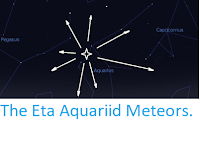The October Camelopardalid Meteor Shower is potentially visible each year on 5-6 October, peaking at about midnight between the two dates. This meteor shower gets its name from the constellation of Camelopardalis, which is circumpolar in the Northern Hemisphere (i.e. always above the horizon), from which meteors appear to radiate. The shower is quite variable, being almost impossible to spot most years, but having produced peaks in 2005, 2006, and 2016. If the meteors do make an appearance this year, then viewing should be reasonably good, as the peak of activity coincides with the New Moon on 6 October.
Meteor showers are thought to be largely composed of material from the tails of comets. Comets are composed largely of ice (mostly water and carbon dioxide), and when they fall into the inner Solar System the outer layers of this boil away, forming a visible tail (which always points away from the Sun, not in the direction the comet is coming from, as our Earth-bound experience would lead us to expect). Particles of rock and dust from within the comet are freed by this melting (strictly sublimation, transforming directly from a solid to a gas due to the low pressure on it's surface) of the comet into the tail and continue to orbit in the same path as the comet, falling behind over time.
The parent body of the October Camelopardalid Meteor Shower is unknown, but the irregular nature of the meteor shower makes it likely that it is a Long Period Comet (i.e. a comet that visits the Inner Solar System less frequently than once every 200 years), and quite possibly one that has not yet been observed at all.
See also...



Follow Sciency Thoughts on Facebook.
Follow Sciency Thoughts on Twitter.






